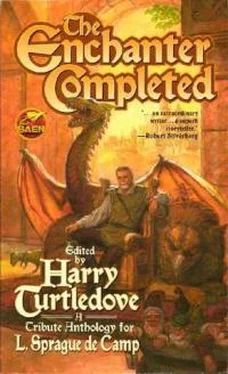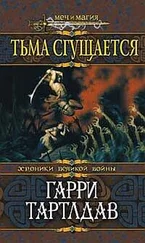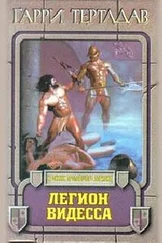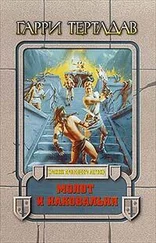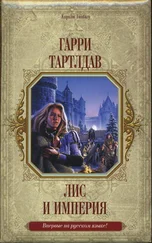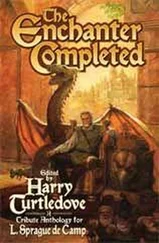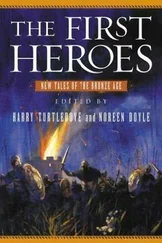Гарри Тертлдав - The Enchanter Completed
Здесь есть возможность читать онлайн «Гарри Тертлдав - The Enchanter Completed» весь текст электронной книги совершенно бесплатно (целиком полную версию без сокращений). В некоторых случаях можно слушать аудио, скачать через торрент в формате fb2 и присутствует краткое содержание. Год выпуска: 2005, ISBN: 2005, Издательство: Baen Books, Жанр: Фантастика и фэнтези, на английском языке. Описание произведения, (предисловие) а так же отзывы посетителей доступны на портале библиотеки ЛибКат.
- Название:The Enchanter Completed
- Автор:
- Издательство:Baen Books
- Жанр:
- Год:2005
- ISBN:0-7434-9904-2
- Рейтинг книги:4 / 5. Голосов: 1
-
Избранное:Добавить в избранное
- Отзывы:
-
Ваша оценка:
- 80
- 1
- 2
- 3
- 4
- 5
The Enchanter Completed: краткое содержание, описание и аннотация
Предлагаем к чтению аннотацию, описание, краткое содержание или предисловие (зависит от того, что написал сам автор книги «The Enchanter Completed»). Если вы не нашли необходимую информацию о книге — напишите в комментариях, мы постараемся отыскать её.
The Enchanter Completed — читать онлайн бесплатно полную книгу (весь текст) целиком
Ниже представлен текст книги, разбитый по страницам. Система сохранения места последней прочитанной страницы, позволяет с удобством читать онлайн бесплатно книгу «The Enchanter Completed», без необходимости каждый раз заново искать на чём Вы остановились. Поставьте закладку, и сможете в любой момент перейти на страницу, на которой закончили чтение.
Интервал:
Закладка:
The second thought was: They're all so young ! . There were a round dozen men and women, every color from ebony-black to pink-white via a majority of brown that included several East Asian types. But none of them looked over twenty; they had the subtle signs—the flawless fine-textured skin, the bouncing freshness of movement—that were lost in early adulthood. It was far more noticeable than the various weirdnesses of their clothing.
Behind them were what looked like movie screens showing aerial shots, or various combinations of graphs and numbers, all moving and in different colors.
"Time travelers, right?" he said. After all, I know time travel is possible. I've had going on fifty years to get used to the concept.
One man—young man—gave a satisfied smile. "Instant comprehension! Just as you'd expect from a superior individual. I told you that the Great Man theory—"
He seemed to be talking upper-class sixth-century Latin, until you noticed that his lip movements weren't quite synchronized with the words and there was a murmur of something else beneath it.
Fascinating, Padway thought. And that's an academic riding a hobbyhorse, or I was never an archaeologist. Evidently some things were eternal.
Some of the others started arguing. Padway raised a hand:
"Please! Thank you very much for saving my life, but if you wouldn't mind a little information . . . "
"Yes, excellent sir," another man said—he was in a plain coverall, albeit of eerily mobile material. "From four hundred years in your future. We are—well, mostly—a study team investigating a crucial point in history . . . your lifetime, in fact, excellent sir."
"Four centuries in which future?" Padway said. "Gothic Rome, or my original twentieth? Twentieth century A.D.," he went on, to their growing bewilderment.
There was a long moment of silence. Padway broke it. "You mean, you didn't know ?" he said.
The argument started up again, fast enough that Padway caught snatches of the language it was actually in, rather than the who-knew-how translation. His mind identified it as a Romance-derived language; something like twentieth-century Italian, but more archaic, and with a lot of Germanic loan words and other vocabulary he couldn't identify.
A slow, enormous grin split the ancient American's face. "Fifty years," he murmured.
Fifty years of politics and administration and warfare and engineering. None of them his chosen profession, just the things he had to do to survive and keep the darkness from falling. If this bunch were from only four centuries ahead in the future Padway had made, he'd done that, with a vengence; they were from the date that in Padway's original history had seen the height of the Vikings.
He'd kept the darkness at bay, and now . . . now he could go back to being a research specialist. The grin grew wider.
Better than that, he'd actually get to know how things turned out ! Making history was all very well, but he'd always wanted to read it more.
The Deadly Mission of P. Snodgrass
Frederik Pohl
This is the story of Phineas Snodgrass, inventor. He built a time machine.
He built a time machine and in it he went back some two thousand years, to about the time of the birth of Christ. He made himself known to the Emperor Augustus, his lady Livia and other rich and powerful Romans of the day and, quickly making friends, secured their cooperation in bringing about a rapid transformation of Year One living habits. (He stole the idea from a science-fiction novel by L. Sprague de Camp, called "Lest Darkness Fall".)
His time machine wasn’t very big, but his heart was, so Snodgrass selected his cargo with the plan of providing the maximum immediate help for the world’s people. The principal features of ancient Rome were dirt and disease, pain and death. Snodgrass decided to make the Roman world healthy and to keep its people alive through twentieth-century medicine. Everything else could take care of itself, once the human race was free of its terrible plagues and early deaths.
Snodgrass introduced penicillin and aureomycin and painless dentistry. He ground lenses for spectacles and explained the surgical techniques for removing cataracts. He taught anesthesia and the germ theory of disease, and showed how to purify drinking water. He built Kleenex factories and taught the Romans to cover their mouths when they coughed. He demanded, and got, covers for the open Roman sewers, and he pioneered the practice of the balanced diet.
Snodgrass brought health to the ancient world, and kept his own health, too. He lived to more than a hundred years. He died, in fact, in the year a.d. 100, a very contented man.
When Snodgrass arrived in Augustus’ great palace on the Palatine Hill, there were some 250,000,000 human beings alive in the world. He persuaded the principate to share his blessings with all the world, benefiting not only the hundred million subjects of the Empire, but the other hundred millions in Asia and the tens of millions in Africa, the Western Hemisphere, and all the Pacific islands.
Everybody got healthy.
Infant mortality dropped at once, from ninety deaths in a hundred to fewer than two. Life expectancies doubled immediately. Everyone was well, and demonstrated their health by having more children, who grew in health to maturity and had more.
It is a feeble population that cannot double itself every generation if it tries.
These Romans, Goths and Mongols were tough. Every thirty years the population of the world increased by a factor of two. In the year a.d. 30, the world population was a half-billion. In a.d. 60, it was a full billion. By the time Snodgrass passed away, a happy man, it was as large as it is today.
It is too bad that Snodgrass did not have room in his time machine for the blueprints of cargo ships, the texts on metallurgy to build the tools that would make the reapers that would harvest the fields—for the triple-expansion steam turbines that would generate the electricity that would power the machines that would run the cities—for all the technology that two thousand subsequent years had brought about.
But he didn’t.
Consequently by the time of his death conditions were no longer quite perfect. A great many people were badly housed.
On the whole, Snodgrass was pleased, for all these things could surely take care of themselves. With a healthy world population, the increase in numbers would be a mere spur to research. Boundless nature, once its ways were studied, would surely provide for any number of human beings.
Indeed it did. Steam engines on the Newcomen design were lifting water to irrigate fields to grow food long before his death. The Nile was dammed at Aswan in the year 55.
Battery-powered street cars replaced oxcarts in Rome and Alexandria before a.d. 75, and the galley slaves were freed by huge, clumsy diesel outboards that drove the food ships across the Mediterranean a few years later.
In the year a.d. 200 the world had now something over twenty billion souls, and technology was running neck-and-neck with expansion. Nuclear-driven ploughs had cleared the Teutoberg Wald, where Varus’ bones were still mouldering, and fertilizer made from ion-exchange mining of the sea produced fantastic crops of hybrid grains. In a.d. 300 the world population stood at a quarter of a trillion. Hydrogen fusion produced fabulous quantities of energy from the sea; atomic transmutation converted any matter into food. This was necessary, because there was no longer any room for farms. The Earth was getting crowded. By the middle of the sixth century the 60,000,000 square miles of land surface on the Earth was so well covered that no human being standing anywhere on dry land could stretch out his arms in any direction without touching another human being standing beside him.
Читать дальшеИнтервал:
Закладка:
Похожие книги на «The Enchanter Completed»
Представляем Вашему вниманию похожие книги на «The Enchanter Completed» списком для выбора. Мы отобрали схожую по названию и смыслу литературу в надежде предоставить читателям больше вариантов отыскать новые, интересные, ещё непрочитанные произведения.
Обсуждение, отзывы о книге «The Enchanter Completed» и просто собственные мнения читателей. Оставьте ваши комментарии, напишите, что Вы думаете о произведении, его смысле или главных героях. Укажите что конкретно понравилось, а что нет, и почему Вы так считаете.
